
- The Column-05-15-2018
- Volume 14
- Issue 5
Postnova Announces Viral Collaboration with University of Helsinki
Postnova Analytics has announced a joint collaboration with the Department of Biosciences at the University of Helsinki in Finland, to use AF4 for the purification of halophilic viruses.
Postnova Analytics (Landsberg am Lech, Germany) has announced a joint collaboration with the Department of Biosciences at the University of Helsinki in Finland, to use asymmetrical flow fieldâflow fractionation (AF4) for the purification of halophilic viruses.
Viruses that persist in extreme environments, such as high salinity or high temperatures, are of particular interest to researchers because of their unique adaptations for survival, and one of the main challenges involved in studying these viruses has been to identify an efficient separation technique-in particular, a separation technique that both purifies and maintains the infectious nature of the viruses.
A recent publication to come out of the collaboration details the technique developed to purify and study extremophilic viruses (1). Four viral morphotypes were successfully purified with high virus recoveries and purities comparable to those of multistep ultracentrifugation purification methods. The paper also explains how to use AF4 as a rapid monitoring tool for virus production in slowly growing host cells living in extreme conditions.
For more information, please visit
Reference
- K. Eskelin et al., Extremophiles21, 1119 (2017).
Articles in this issue
over 7 years ago
Evaluating Marine Algae for Therapeutic Effectsover 7 years ago
Do You Work in an Amazing Laboratory?over 7 years ago
Restek and Girl Scouts Team Up to Promote STEMover 7 years ago
Peak Receives Royal Visit to Celebrate 20 yearsover 7 years ago
A Nontargeted Metabolomic Approach for Organic Food Fraudover 7 years ago
Determination of Organometal Contaminants Using PTV GC–ICP-MSover 7 years ago
Vol 14 No 5 The Column May 2018 North American PDFNewsletter
Join the global community of analytical scientists who trust LCGC for insights on the latest techniques, trends, and expert solutions in chromatography.



